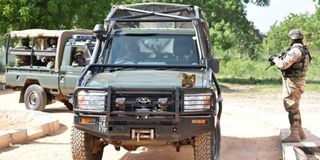Premium
Lamu problem bigger than Kenya

Military officers on duty at Lamu County Commissioner's office during a security meeting on January 9, 2022.
What you need to know:
- On January 5, Dr Matiang’i declared a month-long dusk-to-dawn curfew in some parts of Lamu following a wave of deadly terrorist attacks.
- Perhaps the good people of Lamu sense it but cannot yet put a finger on the changing political fortunes of their region.
The Daily Nation on Tuesday reported that residents of Lamu County had called on Interior Cabinet Secretary Fred Matiang’i to clarify the status of the night curfew there.
On January 5, Dr Matiang’i declared a month-long dusk-to-dawn curfew in some parts of Lamu following a wave of deadly terrorist attacks linked to Somali militant group al-Shabaab and its affiliates. The month has ended but residents say police are using the excuse to shake them down.
Perhaps the good people of Lamu sense it but cannot yet put a finger on the changing political fortunes of their region. The terrorist activities and the curfew seem part of a bigger unfolding geopolitical reality along the entire Eastern African coast.
In September last year, President Kenyatta opened the Manda Bay Forward Operations Base (FOB) after it was upgraded to a full naval base. The base played a key role in the capture of Kismayu in Somalia by the Kenya Defence Forces (KDF) in 2012. The upgrade is aimed, among other things, to protect the Lamu port, which has finally come to life, and the Lamu Port-South Sudan-Ethiopia Transport Corridor (Lapsset) project.
At the event, the Chief of Defence Forces, Gen Robert Kibochi, said the government would invest more in the base to host other national and “international agencies”.
In mid-December, President Kenyatta was back at the coast — this time in Mombasa to commission the Mombasa Shipyard at Kenya Navy Base (KNB), Mtongwe. Kenya Navy has become the centre of attention. Early this month, the peace-loving Danish government gave it a dive boat.
Military presence
Last week, the French Defence Attaché to Kenya, Col Marc De Block, called on the Deputy Commander Kenya Navy, Brigadier Lawrence Gituma, to break bread.
A major sign of the change came last December, when the erratic US President Donald Trump, having dramatically upped the bombing of Somalia, said he wanted America out.
The US forces reportedly pulled out of Somalia, relocated to America’s vast military base in Djibouti, and to its base in Manda Bay, which had earlier suffered a big attack from al-Shabaab fighters that killed an American soldier, two contractors and an undisclosed number of Kenyans. They also destroyed aircraft.
Reading these movements from the outside, there seem to be several factors at play. The rapprochement between Israel and the Gulf states, seems to be changing the significance of the US base in Djibouti, and the strategic role of the Gulf of Aden. The Israel-Gulf axis can now secure the Red Sea and the Gulf of Aden.
The anchor strategic point for many international power players, especially the West, has shifted southwards to the Kenyan coast, specifically Lamu (and the Mozambique coast). That creates a horseshoe that more directly faces towards China across the Indian Ocean.
For its part, China announced last year that it was to establish a permanent military base in West Africa. It is likely that the base will be in Equatorial Guinea. That would be its second base in Africa, after Djibouti, and first permanent military presence on the Atlantic Ocean. And just like a move down to the Kenyan coast gives America a direct line of sight toward China, Beijing would now have a direct line of the US.
Islamist militants
To the north, the line in the water has moved from the Gulf of Aden and the Red Sea to the Mediterranean, where Russia has muscled into Libya and the Sahel countries beset by Islamist militants like Mali, right into the Central African Republic. This seems to be resulting in a downgrade — for lack of a better word — in the strategic significance of Ethiopia, which has been compounded by the recent two-year Tigray war.
“International interests” of the hard security type, if one might write loosely, seem to be facing more to the Eastern and Central African heartland.
It’s a shift that could see an increase in the strategic currency of Uganda, enabling it to do things like move into the Democratic Republic of Congo to fight Islamist militants, as it is currently doing, and Rwanda to go into Mozambique to help a regime weakened by corruption in Maputo, dismantle jihadists who had laid siege to the country’s oil-rich northern Cabo Delgado province for nearly five years.
Additionally, with the Uganda-Tanzania oil pipeline now projected to land in Tanga port at least in 2025, plus the new Lamu port, the expanded Dar es Salaam and Mombasa ports, the upgraded Mamba Bay naval base and others, the value of assets on the East African coast will rise sharply.
The pay-off for enemies like al-Shabaab and its friends is that attacking them will also be big, so they will be more motivated to try, and there will be intensified investment by states in protecting them.
The Lamu people, therefore, have a complicated situation on their hands. Their neighbourhood has become problematic for an otherwise good reason: Its economic and political value has increased.
Mr Onyango-Obbo is a journalist, writer and curator of the “Wall of Great Africans”. @cobbo3





